Reserve Bank of Australia Annual Report – 1994 The Economy and Monetary Policy
Monetary policy in Australia seeks to support economic growth while limiting inflation to around 2 to 3 per cent. This objective is being met. Since the recovery commenced in mid 1991, the economy has expanded by about 10 per cent and inflation has remained around 2 per cent per annum in underlying terms. Over the past year real GDP is estimated to have grown by around 4 per cent, bringing a strong rise in employment and the first reduction in unemployment for four years.
The cash rate – the key policy interest rate – was reduced by half of one percentage point in July 1993. This was the only change during 1993/94. It was made at a time when doubts lingered about the strength and durability of the recovery, and inflationary expectations were still moving downwards. It was the last in a series of interest rate reductions which began in January 1990. The unusually long period of falling interest rates, and the large size of the total reduction in cash rates – some 13 percentage points – reflected both the transition to a world of much lower inflation and the initial hesitancy of the cyclical recovery.
| 1989/90 | |
|---|---|
| 23 January 1990 | ½ – 1 |
| 15 February 1990 | ½ |
| 4 April 1990 | 1 – 1½ |
| 1990/91 | |
| 2 August 1990 | 1 |
| 15 October 1990 | 1 |
| 18 December 1990 | 1 |
| 4 April 1991 | ½ |
| 16 May 1991 | 1 |
| 1991/92 | |
| 3 September 1991 | 1 |
| 6 November 1991 | 1 |
| 8 January 1992 | 1 |
| 6 May 1992 | 1 |
| 1992/93 | |
| 8 July 1992 | ¾ |
| 23 March 1993 | ½ |
| 1993/94 | |
| 30 July 1993 | ½ |
During the second half of 1993, it became increasingly clear that the pace of growth was picking up and broadening. Improving conditions in the industrialised world (especially the United States) helped the acceleration in activity, but the main contributing factor was a resurgence in confidence on the part of businesses and households at home. Businesses responded to stronger sales by hiring additional staff and, by the end of 1993, were taking decisions to invest more in plant and equipment, although overall investment levels remained low. Households, encouraged by the stronger labour market and the lowest nominal interest rates in a generation, extended their borrowings for housing and consumption purposes.

In those circumstances, any further stimulus from monetary policy was unwarranted, especially as the Budget introduced in August 1993 appeared to be mildly expansionary, notwithstanding the projected longer-term reduction in the deficit. Apart from those considerations, two potential trouble spots emerged which, had they got out of hand, could have required higher interest rates.
The first of these – which proved short-lived – was the exchange rate. During August and September 1993, when the markets were uncertain about the Budget's passage through the Senate, the Australian dollar came under intense pressure, reaching its lowest point ever in trade-weighted terms (47.1). This threatened to undermine both price stability and confidence in overall economic policy, and prompted the Board to consider tightening monetary policy. In the event, substantial intervention sufficed as a short-term response, and as the temporary factors undermining the currency passed and confidence about the course of the world economy and commodity prices improved, the exchange rate began to rise; by the beginning of January, the trade-weighted index was 10 per cent above its low point.

The second – and more enduring – potential trouble spot was borrowing for housing, which continued to grow at more than 20 per cent, following similar rapid growth during 1992/93. One risk here was that, if sustained, such large injections of funds would excite expectations of house and other asset price rises, and arouse inflationary expectations more widely. An associated risk was that sustained rapid growth in housing lending, along with increased borrowing for consumption purposes at home-loan interest rates, would leave little room for business credit to grow in line with the projected growth in business investment.
In the event, these risks did not materialise during 1993/94, although they did not disappear either. For most of the year growth in aggregate credit was, if anything, a little below what would normally be expected at current rates of economic activity, although it has picked up in recent months on the back of stronger demand for credit from businesses. Similarly, on most measures, house prices rose only moderately through the year, although some indicators were suggesting more pronounced rises by mid 1994.

Looking at the economy as a whole, no strong case existed for an early tightening of monetary policy. The economy began the year with substantial excess capacity, and there were no signs of a pick-up in underlying pressures on prices for goods and services. Labour costs overall were quite restrained, and expectations about inflation remained low; forecasts for inflation over the short term, in fact, were revised downwards.
For much of 1993/94, then, some tension existed between the potential for over-borrowing to occur in the household sector, and the conviction that the cyclical recovery had further to run before aggregate conditions were likely to warrant a tightening of monetary policy. By the end of the year, however, the various elements had begun to coalesce, with clearer signs the economy was growing more strongly. A key point was reached when US interest rates began to rise in early February, as the Federal Reserve sought to make monetary policy less accommodative. This triggered a sharp and sustained reaction in global bond and share markets, which saw Australian long-term interest rates rise more than most. These movements reflected the markets' expectation that interest rates generally would rise as a result of increased demand for capital and upward pressure on inflation consequent upon stronger US and world growth.
In Australia, the authorities did not accept that the jump in bond yields portended a sharp deterioration in inflationary performance which demanded immediate monetary policy action. At the same time, they acknowledged consistently that monetary policy would be applied in an effective and timely fashion to keep inflation under control. That has come to be accepted in Australia as holding the underlying rate of inflation to 2 to 3 per cent, averaged over a run of years. Maintenance of that objective will have beneficial effects not only on financial markets and longer-term interest rates, but also on labour markets and inflationary expectations generally.
International developments
Australia's trading partners recorded growth of about 3½ per cent in 1993, and stronger growth is expected in 1994 and 1995. Real GDP in the major industrialised economies is forecast to grow by about 2½ per cent in 1994, compared with an average of around 1 per cent over the preceding three years; it is expected to grow a little faster again in 1995. The economies in the Asian region, apart from Japan, have continued to grow rapidly. Both Singapore and South Korea saw a marked increase in growth in late 1993 and early 1994, to around double-digit rates. Hong Kong and Taiwan are recording 5 to 6 per cent growth rates, helped by their close links to China, where industrial production has been growing at rates of 20 per cent or more for the past two years. The Asian economies, which are forecast to contribute around half of the growth in world output in the 1990s, are clearly assuming major importance to Australia.
Economic growth in Australia's trading partners
(Growth in real GDP; per cent)
|
Share of Australian exports |
1992 |
1993 |
1994 (f) |
1995 (f) |
|
|---|---|---|---|---|---|
| OECD | 55.8 | 1.7 | 1.2 | 2.6 | 2.9 |
| United States | 9.5 | 2.6 | 3.0 | 4.0 | 3.0 |
| Japan | 26.3 | 1.2 | 0.0 | 0.8 | 2.7 |
| European Union | 12.1 | 1.0 | −0.4 | 1.9 | 2.8 |
| Asian NIEs* | 20.0 | 5.6 | 6.0 | 6.6 | 6.6 |
| New Zealand | 5.2 | −0.4 | 4.8 | 3.9 | 3.5 |
| Total trading partners | 3.2 | 3.5 | 3.7 | 4.1 | |
|
* Newly industrialising economies Sources: Australian Bureau of Statistics, OECD Economic Outlook June 1994 |
|||||
The main locomotive for the present global recovery, however, remains the United States, where real GDP has expanded by about 10 per cent since its trough in early 1991. By mid 1994, capacity utilisation had reached historically high levels, and the unemployment rate had fallen to around 6 per cent, close to levels at which inflationary pressures have begun to increase in the past. Against this background, and the action taken by the Federal Reserve to tighten monetary policy, growth in the United States is forecast to ease back over the year ahead.
Signs of recovery have increased across Western Europe. In the United Kingdom and some other countries which saw their exchange rates and interest rates decline during 1992, recovery has been under way for some time. These countries are now being joined by Germany and other ERM countries; a key factor here has been the significant slowing in price and cost pressures in western Germany, which has helped the Bundesbank to ease short-term interest rates by about 2½ percentage points during the course of 1993/94. The short-term outlook is for a strengthening cyclical recovery in Europe, although structural problems (in the form, for example, of inflexible labour markets and substantial budget deficits) are possible constraints on growth in the medium term.

Japan will be the last of the major economies to emerge from recession, after the most prolonged period of weakness in its modern history. Problems of excess capacity have been compounded by weak corporate and financial sector balance sheets and the effects on confidence of political instability. An appreciating exchange rate also has made it more difficult for many Japanese firms to compete internationally. Recent indicators suggest that the trough has been passed but that growth will resume only slowly.

The better outlook for OECD economies has pushed up a number of commodity prices. The price of wool increased by 50 per cent through the year, in SDR terms, from the very low levels of mid 1993. In the case of base metals, including in particular aluminium, prices have risen by close to 30 per cent since their trough, although again they remain at relatively low levels historically. Perceptions of higher inflation also saw intermittent upward pressure on gold prices. These developments were, in themselves, positive for the incomes of Australian producers. Some other key prices, however, moved in the opposite direction, the most important being lower contract prices for coal and iron ore, which reflected the recessed state of Japanese industry. Overall, Australia's terms of trade have remained flat, at their lowest level since the mid 1980s. As global growth picks up, some further rises in commodity prices and a lift in the terms of trade are likely, although continuing high stocks of base metals and wool, and the contractual basis of coal and iron ore prices, suggest that prices generally are unlikely to bound ahead.
The price of crude oil has increased in recent months but it remains below the levels recorded during most of the 1990s. This, together with substantial unused capacity for many products throughout the world, contributed to low rates of inflation in the major industrial countries in 1993/94; underlying inflation was generally at the lowest level since the early 1960s. In today's low inflation world, Japan has achieved virtual price stability, with some price indices actually falling, while German inflation is returning to more customary levels. Even in the United States, the economy closest to full capacity, price pressures have been well-contained, helped in part by competitive world markets. In the developing Asian economies, inflation has edged up, but remains generally in single digits. Of Australia's main trading partners, only China is experiencing high inflation.
The rise in bond yields around the world, if sustained, could be expected to have some dampening effects on growth prospects, particularly in countries where substantial business lending is on extended fixed-interest terms. Governments also face higher funding costs. Share prices too have fallen somewhat, raising the cost of equity finance and checking confidence. While the net effect of sustained higher long-term rates is contractionary, it is unlikely to substantially offset the various expansionary forces now operative in many economies.
Domestic economic activity
At around 4 per cent, the domestic economy is growing fast enough to wind back unemployment and surplus physical capacity. Growth is being driven by increases in both domestic demand and exports. By mid 1994, GDP had grown by about 10 per cent from its low point in the middle of 1991; this is similar to the upswing in the United States, and well ahead of the recoveries in almost all other industrial countries.

As in the previous year, domestic demand was led by a rise in household expenditure. Dwelling investment recorded another substantial rise, with the lowest nominal interest rates in two decades helping to fuel another 20 per cent increase in new loan approvals for owner-occupiers; investors increased their borrowings even more rapidly, with the value of approvals for investor housing loans rising by almost 60 per cent, to a new peak. With spending on alterations and additions rising, total dwelling investment in real terms is estimated to have risen by over 9 per cent. Turnover in the market for established dwellings also increased substantially. This market attracts three out of every four dollars borrowed for owner-occupied housing. Compared with the smaller market for newly constructed dwellings, it is driven less by underlying demographic demands, and more by inflation perceptions and taxation treatments which, traditionally, have made “bricks and mortar” investments so attractive to Australians.

Consumer spending also grew more quickly during 1993/94, with private consumption rising by around 3 per cent, its strongest growth in four years. This strength stemmed from greater confidence – measures of consumer sentiment reached their highest levels in 20 years – and faster growth in incomes, both factors in part reflecting the firmer tone in the labour market. To some extent, too, it was facilitated by an expansion in borrowing, with the “other personal” category of credit rising for the first time in several years.
Business investment spending, on the other hand, increased much more modestly. Abstracting from transfers of assets between the public and private sectors and some other lumpy items, spending both on structures and plant and equipment appear to have recorded small rises in real terms. Relative to national income, however, equipment investment remained at unusually low levels.

The pre-conditions for investment are in place. The level of corporate profitability and the strength of company balance sheets have both improved further over the past year, and the cost of capital remains relatively low, despite recent increases in longer-term rates. Apart from the gains in capital productivity delaying the need for investment in some firms, the past weakness of investment appears to reflect ongoing uncertainty about the strength of the recovery. With businesses now showing stronger sales growth, and production and capacity utilisation rising, that uncertainty has been reduced (as surveys of business sentiment affirm), which should bring investment plans closer to fruition. A significant rise in investment appears to be in prospect over the coming year.
The manufacturing sector recorded further impressive gains over the past year, with total output growing by around 10 per cent and exports by around 18 per cent. Farm production rose strongly, helped by a substantial increase in most crops, especially cereals; the wool clip fell and livestock slaughtering was flat. Mining output was sluggish, as demand from Japanese steel mills for coking coal and iron ore weakened, and was only partly offset by stronger demand from other Asian countries. Among service industries, solid increases occurred in the telecommunications and transport sectors, reflecting, in part, regulatory changes to free up these markets.
The labour market
The effect of the faster growth in output was seen quite clearly in the labour market during 1993/94.
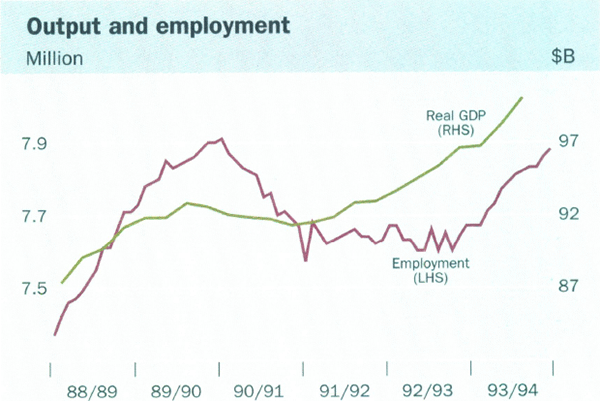
In the preceding year, the subdued recovery was accompanied by labour-shedding in many companies, and did not generate any net additional demand for labour, while the workforce continued to expand with population. The result was that the rate of unemployment was higher 18 months into recovery than it was at the low point of the cycle. Over the past year, however, labour market conditions firmed appreciably. The rise in job vacancies accelerated sharply, growing by 64 per cent over the year to May 1994. In the private sector, vacancies rose even faster, to their highest level since late 1989.
From September 1993, employment began to grow consistently, and had risen by over 200,000, or 2¾ per cent, by June 1994. Two-thirds of these new jobs were full-time and occurred in several areas, including wholesale/retail trade, community and recreation services and finance/business services. The manufacturing sector, which has rarely expanded its workforce in the past two decades, also increased its demand for labour.
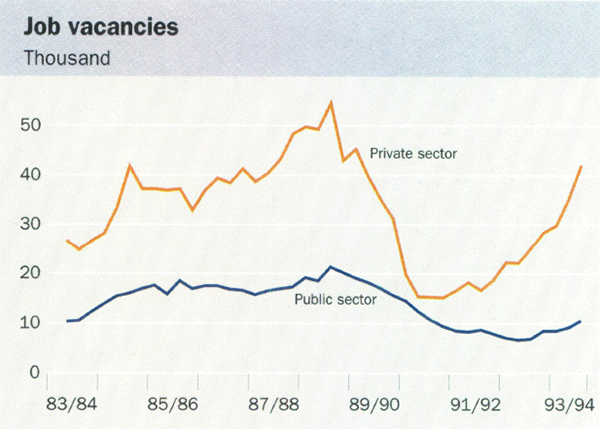
Unemployment fell to 10 per cent in the middle of 1994, compared with 11 per cent a year earlier, and further reductions are expected over the year ahead. This trend should help to lay to rest the more morbid predictions about “jobless growth”, and permanent double-digit unemployment, which were common a short time ago. In its submission to the Committee on Employment Opportunities, the Bank argued that economic growth at or above 4 per cent per annum would reduce unemployment. The critical factor in securing a durable reduction in joblessness, however, is to sustain such growth over a number of years. That requires support from – and timely adjustments in – all areas of macro and micro-economic policies.
So far as the labour market is concerned, a good deal of unused capacity clearly remains. While there is no precision in estimates of “full” employment, or the so-called “non-accelerating inflation rate of unemployment”, they are closer to 6 per cent than the current 10 per cent. Capacity utilisation, on the other hand, is likely to return to more “normal” levels rather faster than the rate of unemployment, given the low rates of investment over recent years. In manufacturing, capacity utilisation has been rising with the rapid growth in output. In the broader economy, where the services sector makes up a large proportion of the total, measures of capacity utilisation have a less tangible meaning, but the responses by business to surveys suggest that perhaps half of the fall in capacity utilisation in the recession has now been reversed.
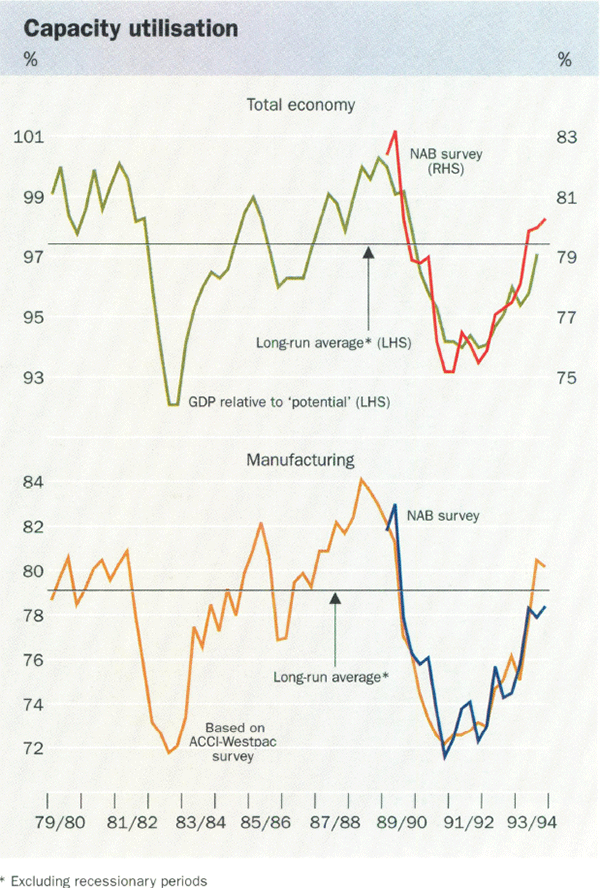
Over the next couple of years, as businesses move closer to full capacity, and put in place new capacity and hire extra workers, the economy could be more susceptible to inflationary shocks than it has been in the past few years. During this phase, policy-makers will need to remain especially vigilant, and be prepared to adjust policies in response to any threats of upward pressure on inflation.
Inflation
Although the phase of falling inflation ended some time ago, there are few signs of an actual pick-up in the rate of inflation. The published or “headline” Consumer Price Index rose by 1.7 per cent over the year to June, following a rise of 1.9 per cent over the previous 12 months. Monetary policy, however, focuses on “underlying” inflation, hich abstracts from temporary or special factors (such as policy changes which affect interest rates, taxes or government charges). Measures of underlying inflation are inevitably imprecise, because the abnormal influences can change over time. A variety of measures, however, suggests a broadly similar picture of the underlying rate of inflation remaining around 2 per cent in 1993/94, for the third successive year.
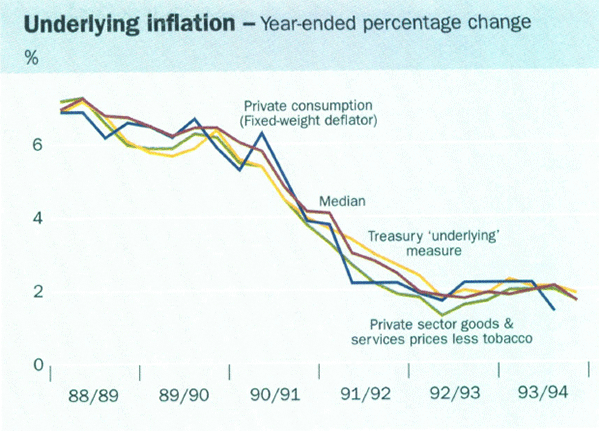
Selected price and cost measures
(Percentage change over year to quarter or month shown)
| June 1991 | June 1992 | June 1993 | Latest | |
|---|---|---|---|---|
| Consumer prices | ||||
| Consumer price index | 3.4 | 1.2 | 1.9 | 1.7(1) |
| Private sector goods and services* | 4.1 | 2.1 | 2.5 | 2.1(1) |
| adjusted for tobacco taxes | 3.8 | 1.9 | 1.7 | 1.7(1) |
| Private consumption deflator# | 3.9 | 2.2 | 2.2 | 1.4(2) |
| Median CPI** | 4.2 | 2.5 | 1.9 | 1.7(1) |
| Treasury underlying measure | 4.0 | 2.7 | 1.9 | 1.9(1) |
| Producer prices | ||||
| Manufacturing inputs | 3.3 | 3.5 | 2.1 | −1.7(3) |
| Imported goods | 2.2 | 2.3 | 11.3 | −0.4(3) |
| Manufacturing outputs | 2.7 | 1.4 | 2.3 | 1.0(3) |
| House-building materials | 2.7 | −0.4 | 4.2 | 3.7(3) |
| Other building materials | 3.3 | −1.0 | 1.3 | 1.7(3) |
| Broader measures | ||||
| Domestic final demand deflator# | 3.1 | 1.7 | 2.2 | 1.3(2) |
| Gross Domestic Product deflator# | 1.9 | 1.4 | 0.9 | 0.8(2) |
| Nominal labour costs | ||||
| Award wages | 2.6 | 3.4 | 0.9 | 1.1(3) |
| Private sector ordinary-time earnings | 4.3 | 4.4 | 1.1 | 2.6(4) |
|
* Total CPI less fresh fruit and vegetables, fuel, mortgage interest charges,
consumer credit charges, public dwelling rents, local government rates
and charges, household fuel and light, postal and telephone services,
motoring charges, urban transport fares, health services, pharmaceuticals,
and education and child care Sources: Australian Bureau of Statistics, Commonwealth Treasury and Reserve Bank. |
||||
Producer prices also increased quite modestly. Manufacturing output prices rose by 1.0 per cent over the year to May, with lower oil prices reducing input costs; excluding petroleum products, output prices rose by 1.7 per cent over the same period. Prices for construction materials were, for the most part, relatively steady with weakness in non-dwelling construction making room for the high levels of dwelling construction without major increases in prices. The exception was timber prices, which again rose sharply, in line with timber prices worldwide. Excluding timber, construction materials prices rose by 1.5 per cent over the year to May. The implicit price deflator for GDP rose by around 1 per cent over the year to the March quarter; apart from the slow growth in labour and materials costs, this also reflected the overall weakness of prices for commodity exports.
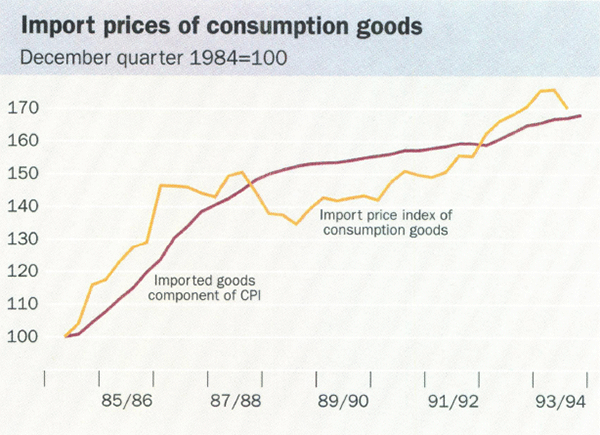
Import prices contributed little to domestic inflation in 1993/94, despite the 20 per cent depreciation of the Australian dollar between late 1991 and late 1993. Items in the CPI which have a large import component rose by 2.4 per cent over the year to June 1994, with the largest increase occurring in prices for motor vehicles. Over the three years to June, the total rise in final prices for imported consumption goods was around 7 per cent, which was slightly below the rise in prices for the non-imported goods component of the CPI.
Several factors contributed to this favourable outcome. Import prices at the consumer level have a significant component of domestic input costs, which are unaffected by exchange rate movements. In addition, importers' margins appear to have expanded during the period when the exchange rate was high in the late 1980s, creating some “fat”. Again, import prices in foreign-currency terms have been quite stable, reflecting the slack in the industrialised countries. A fourth factor has been the ongoing tariff cuts, which have reduced the domestic prices of certain imports. By the middle of 1994, with the exchange rate strengthening, the threat to inflation posed by higher import prices had receded. In May, the import price index was actually slightly below its level of a year earlier. On present indications, there does not seem to be a serious risk of inflationary pressure from higher import prices over the year ahead.
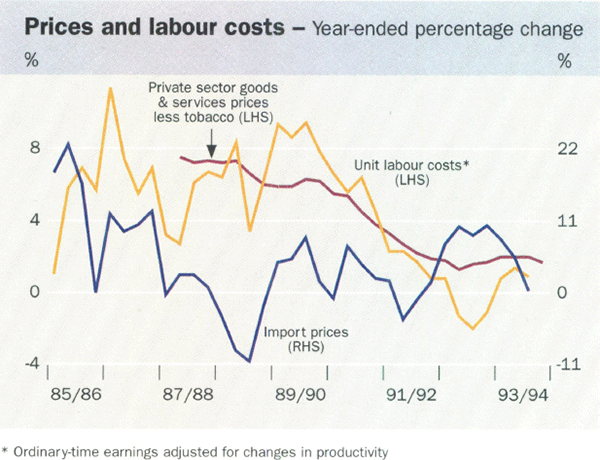
The impetus to price increases from labour costs also has remained fairly subdued to date. Pay settlements under the new wage-bargaining arrangements continued to spread during 1993/94, and at last count about one quarter of the workforce had an agreement of some kind with their employer, with the amounts and timing of increases quite varied. For workers on minimum awards who had been unable to negotiate an enterprise agreement, the Industrial Relations Commission awarded a “safety net” increase of $8 per week (about 1¼ per cent of average ordinary-time earnings), from December 1993. Reflecting these developments, and informal “flow-ons” to the rest of the employed workforce, the ABS survey measure of average weekly ordinary-time earnings rose by 3.2 per cent over 1993/94. Given the good overall productivity performance, this is consistent with price stability objectives.
Looking ahead, the odds are that inflation could rise a little over the coming year, as stronger demand conditions lead to less discounting and generally favour price-setters more than in the recent past. Firmer labour markets and good ongoing levels of corporate profitability are also likely to add to wage pressures. It is the role of monetary policy to help moderate any excess demand pressures that might develop. By demonstrating a firm resolve to keep inflation under control and thereby help to shape inflation expectations, it can also encourage wage moderation. Monetary policy cannot, however, directly deliver low wage increases, short of being implemented with such vigour as to risk creating further unemployment and slack in the economy.
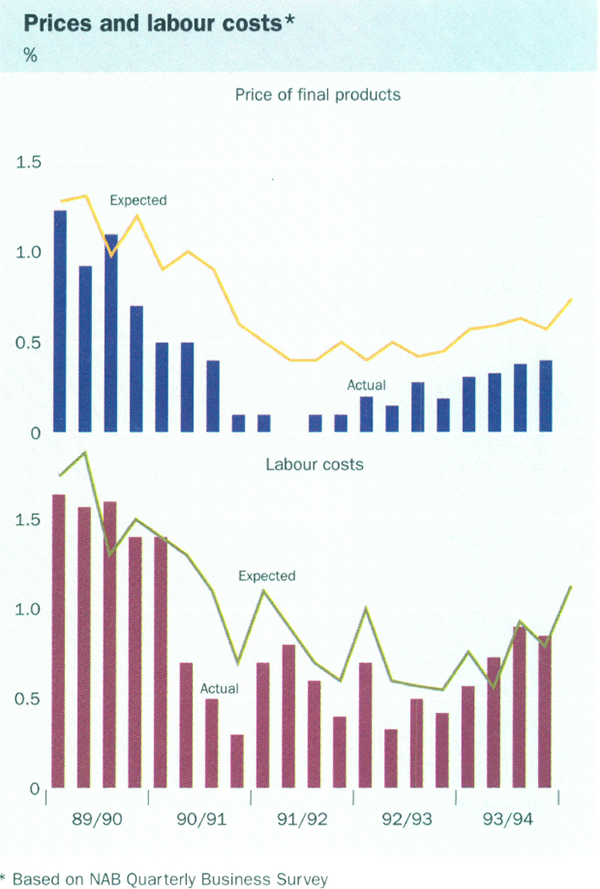
That is why so much hinges on labour market developments. Current enterprise agreements appear to involve annualised increases in the 3½ to 4 per cent range. With the centralised “safety net” adjustments limited to two further annual increases of $8, there should be moderation in pay rates at the most basic level. As enterprise-based agreements come to play a more important role, it is likely that some individual agreements will be reached which embody significantly higher wage increases, in line with productivity performances in those particular enterprises. There have been examples already of this. Although not problems in themselves, difficulties would arise if such agreements were to trigger widespread claims which could not be matched by productivity gains. The result would be increases in unit labour costs which could threaten the objective of price stability; monetary policy will have to take any such developments into account.
Balance of payments
Robust growth was recorded in export volumes of all major categories in 1993/94, with manufactures, in particular, up by about 17 per cent. For manufactures and the rural sector, growth in volumes translated into similarly strong growth in export values, although weak minerals and energy prices through much of the year limited the growth in export earnings in that sector. Exports of most services grew strongly, with tourism leading the way.
Imports responded to the faster growth in Australia and rose by about 8 per cent in both volume and value terms. In the year to June, imports of machinery and industrial equipment and computers, the two largest components of capital imports, increased by 18 per cent. Service imports also began to grow more quickly; these had been very weak for several years, mainly because of reduced spending by Australians on overseas travel.
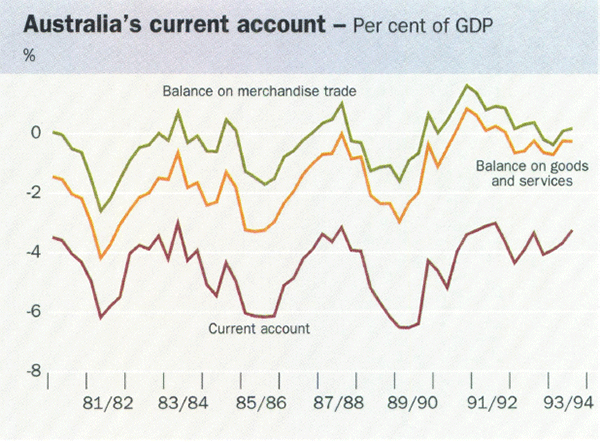
The net effect of these developments was that the balance on goods and services changed little in 1993/94. In volume terms, net trade in goods and services appears to have made a modest positive contribution to growth in GDP, something which does not usually occur when Australia is growing faster than its OECD trading partners, and which suggests that structural adjustment in Australia's trade accounts is still under way. As a result, there was only a small rise in the current account deficit in 1993/94, from $15.3 billion to $15.9 billion (about 3¾ per cent of GDP).
The financial restructuring undertaken by the corporate sector continued to influence the pattern of gross capital flows into Australia, as did the strength of the domestic equity market. Private sector debt inflows fell through most of the year, as the corporate sector ran down its debt, while equity inflows rose to an historical high. Portfolio investment made up the bulk of these inflows, as foreign investors sought to share in the high returns available on equities.
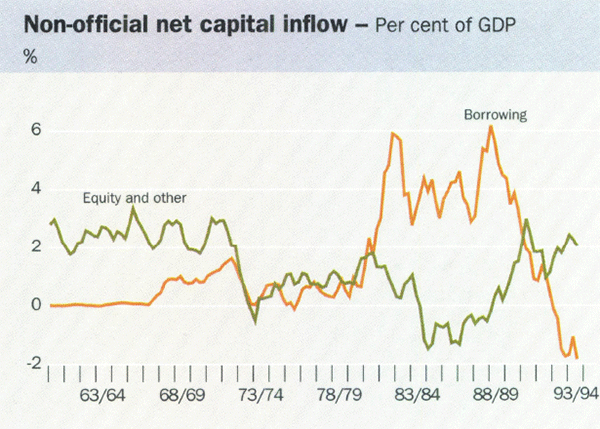
Net foreign debt declined, reflecting the shift towards increased equity inflows, and the valuation effects of a stronger Australian dollar. Current estimates point to a level of net debt equivalent to around 38½ per cent of GDP in mid 1994, compared with 41½ per cent in mid 1993.
Some widening of the current account deficit is likely in 1994/95 as imports respond further to continuing strong domestic activity and the projected recovery in business investment. The beginnings of such a trend are already evident in the June quarter balance of payments figures. This is a normal part of cyclical recovery in the Australian economy which has been somewhat delayed this time around by the sluggishness of investment.
The extent of this cyclical influence will largely reflect the balance between demand and domestic productive capacity. If demand runs ahead of capacity, it will spill over into imports and widen the current account deficit. This is what happened in 1989/90, when the deficit reached 6 per cent of GDP. On this occasion the current account deficit is not expected to increase to the very high levels reached during the late 1980s. In addition to the more moderate pace of the current expansion, assistance is likely also from some other factors, including low inflation and correspondingly lower debt service payments than in earlier periods, improved commodity prices as the world recovery gathers speed, and perhaps most importantly, continued strong export performances by Australian businesses in response to ongoing structural adjustment in the economy.
As in the past several years, a clear example of this adjustment is the strong growth in manufactured exports noted earlier. The gains in competitiveness achieved since the mid 1980s have supported this strong growth, as has the buoyancy of the Asian markets, the most important destination for our manufactured exports. Aided by these developments, Australian manufacturers' shares of world trade in manufactures, and of exports to Asia, while still small, have been rising. Australia's share of total imports into Asia from outside Asia – that is, excluding the phenomenal growth of intra-Asian trade – has grown over recent years, and Australian manufactured exports to non-Japan Asia have outpaced that region's total manufactured imports.
| 1988 | 1992 | |
|---|---|---|
| Manufactured goods | 0.5 | 0.7 |
| Total merchandise | 2.4 | 2.4 |
| Total merchandise (excluding intra-Asian trade) | 3.2 | 3.7 |
Looking beyond the cycle, structural trends in the current account will reflect the underlying savings and investment behaviour of the economy. In other words, longer-term improvements in the current account will depend on further progress in raising domestic savings. Measures to encourage superannuation savings have been in the right direction but increased government “saving” through lower budget deficits remains the clearest opportunity for significant progress.
Financing
The pace of financial intermediation picked up during 1993/94, with household borrowing again leading the way. Total credit grew by 7 per cent over the year, accelerating to an annual rate of 8½ per cent in the second half of the year.
The strong expansion in credit to households over the past two years has seen gross household indebtedness rise significantly relative to income, although it remains modest by international standards. The relatively low starting-point possibly reflects the effects of high interest rates in the late 1980s, which constrained households from taking full advantage of financial liberalisation, as well as the fact that the new entrants to the banking sector in the 1980s had a business, rather than household, focus in their lending. These constraints have been lifted of late, when the cyclical boost to borrowing has combined with the structural adjustment to higher debt levels.
A continuation of the recent pace of such borrowing, however, has the potential to raise a number of problems. Apart from the short-term implications for the housing market mentioned earlier, a longer-term issue concerns the appropriateness of using more of the nation's savings to finance high levels of household spending, at a time when those savings already fall well short of what is required to finance the investment needs of a growing economy. With rising debt ratios, there is also the attendant concern that more households will become exposed to the risk of rises in interest rates.
Household borrowing will therefore need to slow as business borrowing recovers, if total credit growth is to remain within reasonable bounds. Businesses have made few demands on intermediaries for credit over the past couple of years, preferring to tap equity markets for any external funds required to fund their modest levels of investment and to restructure their balance sheets. More recently, however, with confidence returning, business credit has shown signs of growing again, for the first time in three years. This, together with stronger personal borrowing, has pushed up the growth rate for overall credit.
Financial aggregates
(Six-months-ended percentage change, at annual rates*)
| Dec 1992 | June 1993 | Dec 1993 | June 1994 | |
|---|---|---|---|---|
| Credit | −0.3 | 4.8 | 5.8 | 8.5 |
| – Housing | 19.2 | 18.0 | 22.6 | 23.0 |
| – Personal | 0.7 | −2.2 | 2.5 | 4.8 |
| – Business | −8.6 | −0.4 | −2.4 | 0.5 |
| Currency | 7.2 | 6.6 | 5.1 | 8.4 |
| M1 | 11.2 | 21.6 | 16.2 | 18.3 |
| M3 | 4.8 | 8.0 | 4.4 | 9.3 |
| Broad Money | 0.6 | 6.1 | 1.6 | 10.3 |
| * Figures are adjusted for major breaks in series | ||||
To fund this higher credit growth, borrowing by financial intermediaries also has increased. This has meant faster growth in most of the monetary aggregates, a trend which has been reinforced by intermediaries shifting their funding more towards domestic sources as domestic incomes improved, and relying less on foreign funding sources than in recent years. The bulk of the additional deposits in banks and most NBFIs has come from the household sector, which has also increased its holdings of equities.
The M3 and Broad Money aggregates, which largely comprise domestic borrowings by financial intermediaries, grew at about the same pace as total private credit, and broadly in line with the growth in nominal national income. If anything, growth in these aggregates previously had been a little below what would be suggested by their historical relationship with nominal income. M1, which comprises cash and transactions accounts at banks, recorded another year of rapid growth. This aggregate continues to be boosted by the spread of chequeing facilities to a wider range of bank accounts, as well as by ongoing adjustments to lower nominal interest rates (which have reduced the incentive to economise on currency and demand deposits). The stock of currency in circulation grew at an annual rate of 6 to 7 per cent in 1993/94, in line with the growth in nominal national income.
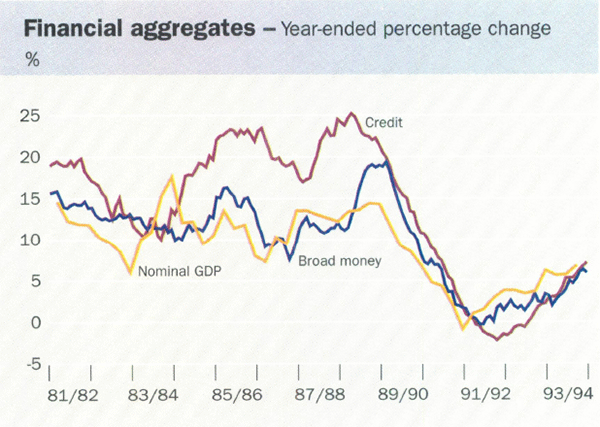
Government demand for funds remained quite large, although public borrowing generally was smaller than was forecast a year ago. The Commonwealth budget deficit for 1993/94 was $13.7 billion, compared with the $16 billion that had been forecast. The total public sector borrowing requirement (PSBR) likewise was smaller than expected, at around 3½ per cent of GDP, compared with the forecast of around 5 per cent. Part of this improvement reflects changes in the accounting treatment of certain expenditures, but part also reflects the stronger-than-anticipated growth in the economy, which increased tax revenues and lowered outlays at the level of both Commonwealth and State governments.
The 1994/95 Commonwealth budget provides for a deficit of $11.7 billion, equivalent to 2.5 per cent of GDP. The deficit is projected to decline further, to under 1 per cent of GDP by 1996/97.
Achieving – and hopefully doing better than – this planned reduction in the deficit will have an important bearing on the level and composition of growth in the years ahead. Within the time horizon of the cycle, the budget stimulus initiated in the period of economic weakness has to be wound back to make room for the necessary growth in business investment and to avoid a disproportionate share of adjustment falling on monetary policy. Beyond the horizon of the cycle, an equally vital structural change is needed, whereby Australia reduces its reliance on foreign savings, so that high levels of investment can be maintained without the current account deficit becoming a major concern.
Monetary policy and growth
The current pace of economic expansion is faster than the long-term sustainable growth rate for the Australian economy but it is feasible for a time yet, given the slack which exists, particularly in the labour market. Success in reducing unemployment will require the upswing to be durable, and that has to be the chief focus of policy.
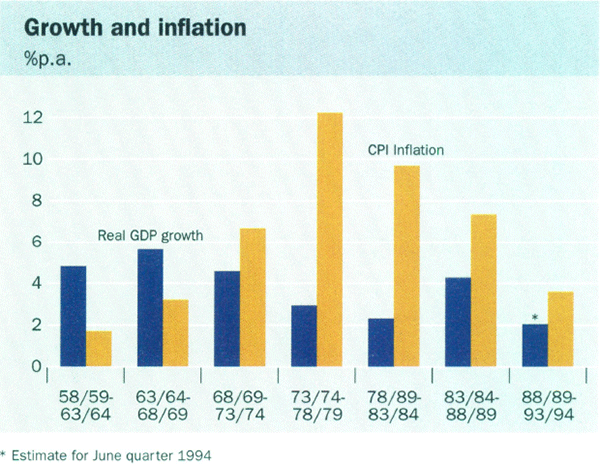
This objective is consistent with low inflation. Indeed, Australia's best-sustained growth performances have usually been in periods when inflation was contained. From the mid 1950s until the late 1960s, for example, growth averaged almost 5 per cent and inflation about 2½ per cent. Historical precedent is not the only reason for confidence that robust growth and low inflation can coexist. New and powerful forces now operative in Australia will help in keeping prices in check. The increased emphasis on productivity improvement is an important element. Reinforcing this is the increasingly competitive nature of product markets, where ongoing reductions in protection and stronger pro-competition forces domestically require businesses to be competitive if they are to grow. Moreover, exchange rate flexibility helps the economy to adjust more easily to offset the inflationary impact of terms of trade changes. By building further on these and other changes, Australia can sustain its good growth and inflation performances.
Short-term interest rates were last adjusted in July 1993. The rates at that time were appropriate for an economy in the early stages of recovery, with no pressures on inflation. The Consumer Price Index is still not recording any slippage on inflation, but the cycle has moved to a new phase in which price-discounting and margin-trimming have become less common, and the strong wage discipline of a recessed labour market does not operate to the same extent. These changes are starting to show up in business surveys.
As strong growth continues, the policy settings which were established in the period of recession and slow recovery will cease to be appropriate. Some upward adjustment of short-term interest rates will become necessary in these circumstances, not because price stability is being eroded in any structural sense, but to help ensure that this does not happen down the track. Moderate and timely adjustments in interest rates will not bring the recovery to a halt. On the contrary, by withdrawing a degree of stimulus, policy adjustments will help to reduce the risks of the economy overheating, and thereby contribute to a more durable recovery.
Financial markets, worldwide, have shown their concern about the inflationary potential of the growth phase of the cycle. Bond yields moved up more in those countries, such as Australia, which are relatively advanced in their cyclical upswings. As is often the case, markets have carried their reaction further than can be explained by any objective evidence, and they have also been more-than-usually susceptible to shifting sentiment and the effects of the actions of a few large players. That said, the sharp rise in long-term interest rates in Australia since February suggests that those responsible for investing large volumes of savings are not fully convinced of the resolve of policy to keep inflation in check.
The Bank believes that the degree of scepticism and fear exhibited in markets in recent months is misplaced, and that a heavy-handed response to those market concerns on the part of monetary policy is unwarranted. Despite strong market pressure to raise interest rates over recent months, the Bank stayed its hand, believing that its actions should be set by the requirements of the domestic economy, rather than the demands of the markets. At the same time, the Bank has made clear its intention to adjust interest rates as required to keep inflation low and help make for a durable recovery.
The only way to sustain low interest rates is to maintain low inflation and to engender confidence that inflation will remain low. Inflationary expectations have declined in Australia over recent years, and that has allowed a much larger fall in nominal interest rates than would have been possible otherwise. If those expectations can be kept low, interest rates in Australia in the 1990s will be much lower, on average, than they were in the 1980s, and the costly distortions imposed by inflation will be avoided. Helping to bring about that situation is perhaps the most significant contribution that monetary policy can make towards realising the potential for strong and durable growth in living standards.